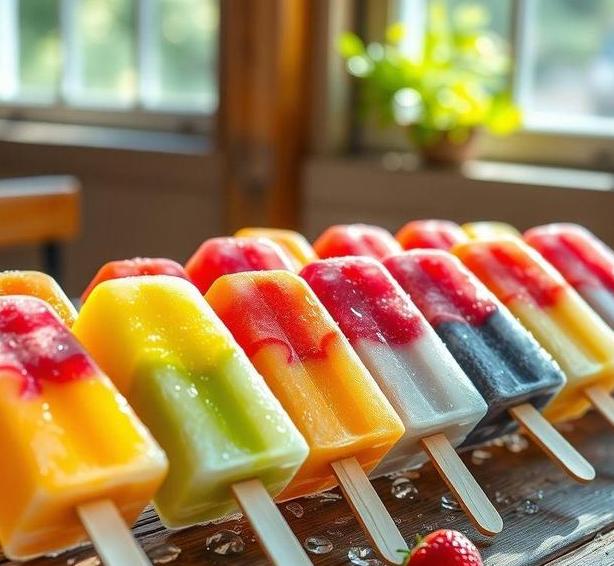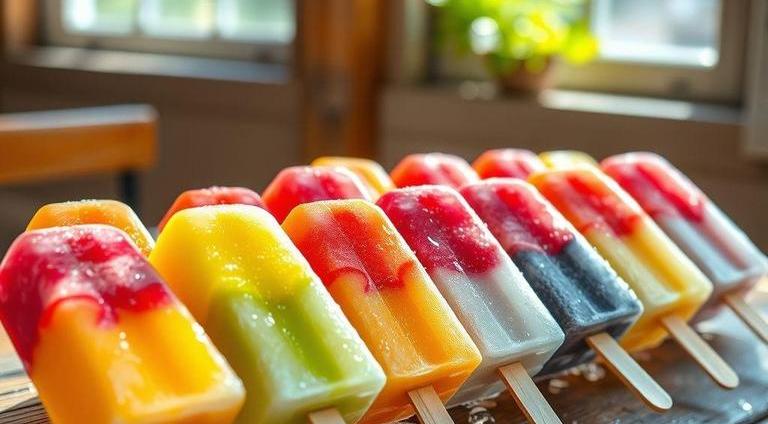Popsicles-those colorful, ice-cold delights-have been a beloved treat for generations. Whether enjoyed on a hot summer day or as a quick dessert to cool off, they offer a burst of sweet refreshment in every bite. But, like all foods, popsicles have a lifespan, and they don’t last forever. So, have you ever wondered, do popsicles go bad? How do you know when it’s time to toss that melting, frosty treat from the freezer? If you’ve got a stash of popsicles tucked away in your freezer, this article is for you. We’re going to take an in-depth look at everything you need to know about the shelf life of popsicles, how to tell if they’ve gone bad, how to store them properly, and some expert tips to keep them tasting their best.
Can Popsicles Go Bad?
While popsicles are frozen and made primarily of water and sugar (along with other ingredients like fruit juice, flavorings, or sometimes cream), they can go bad, albeit in a way that’s often subtle and difficult to detect at first. Freezing doesn’t halt bacterial growth completely; it simply slows it down. Over time, popsicles can suffer from a few issues that can make them unpleasant or even unsafe to eat.
Here’s the catch: popsicles don’t spoil the same way that fresh foods do. Instead of developing visible mold or a strong, sour smell like a piece of fruit or meat, popsicles might just lose their flavor, texture, or consistency over time. They’ll remain frozen, but they can degrade in quality, which could mean they’re no longer enjoyable to eat.
So, yes, popsicles can go bad, but they’ll typically give you clues-like freezer burn or changes in flavor-before they completely become inedible.
Shelf Life For Popsicles

The shelf life of popsicles depends on a variety of factors-primarily how they’re stored and the ingredients they contain. Generally speaking, here’s what you can expect in terms of longevity:
- Homemade Popsicles: These typically last about 1-2 months in the freezer if they’re properly sealed in airtight containers or molds. Because homemade popsicles often contain fresh ingredients, their shelf life can be a bit shorter than store-bought varieties.
- Store-Bought Popsicles: These generally have a longer shelf life, often lasting between 6 months to 1 year in the freezer. They contain preservatives that help maintain their taste and texture longer. However, for the best taste and quality, it’s still recommended to consume them within the first few months.
Remember, these timelines assume the popsicles are kept frozen consistently at the right temperature. A change in freezer temperature (like frequent door openings or a malfunction) can drastically shorten their shelf life.
Common Signs Of Spoilage
You may not always notice right away that your popsicles have gone bad, but there are several telltale signs you can look for. Let’s dive into these key indicators:
-
Freezer Burn
- The most common sign that popsicles are past their prime. Freezer burn happens when popsicles are exposed to air inside the freezer, causing dehydration and crystallization. The popsicle may look frosty, with areas that are discolored or icy.
- Freezer burn won’t make the popsicle unsafe to eat, but it will affect the taste and texture. Expect a drier, more icy bite rather than a smooth, refreshing treat.
-
Off Taste
- If the popsicle has an odd, stale, or sour flavor, it’s likely gone bad. The sugar and other ingredients might degrade over time, especially in homemade varieties, leading to unpleasant flavors.
- A change in taste is one of the clearest indicators that the popsicle has lost its quality.
-
Color Or Texture Changes
- Popsicles that have changed color (such as turning dull or faded) or have an inconsistent texture (like icy chunks or separations in the liquid) are a sign that the ingredients have broken down.
- These changes can occur from improper storage or simply from the popsicle being kept too long.
-
Melting Or Refreezing
- If the popsicle has been allowed to melt and then refrozen, it’s likely lost its texture and could have a mushy consistency. If you see pooling water or the popsicle seems oddly soft or slushy, it’s best to throw it away. Repeated thawing and refreezing cause ice crystals to form, leading to a less enjoyable experience.
How To Store Popsicles?

Proper storage is essential to keeping popsicles fresh and extending their shelf life. Here are some expert tips on how to store popsicles in the best way:
-
Airtight Containers
- Whether you’re storing homemade or store-bought popsicles, airtight containers or sealed plastic bags are key. If the popsicles are exposed to air, they’re more likely to develop freezer burn.
- For homemade popsicles, use resealable bags or plastic wrap to cover the popsicle molds tightly before placing them in a container.
-
Keep Them At A Consistent Freezer Temperature
- Popsicles should be stored at a steady 0°F (-18°C) or colder. Fluctuations in temperature-such as the freezer door being opened too often or the freezer not being cold enough-can cause popsicles to thaw slightly and refreeze, leading to textural issues.
-
Avoid Storing Near The Door
- The door of the freezer is the warmest area, and opening it frequently can cause popsicles to partially thaw and then refreeze. Store them deeper in the freezer, where the temperature is more consistent.
-
Group Popsicles Together
- Storing popsicles close together can help maintain their temperature by limiting the amount of air around them. If you’re storing a large batch, try to create a barrier between different flavors to prevent them from freezing together.
Expert Tips
- Consider Flavor Preservation: If you’re making your own popsicles, consider using ingredients that are more stable in freezing conditions. Pure fruit juices, simple syrups, and yogurt-based popsicles tend to freeze better and last longer than fresh fruit or cream-based ones, which can separate or curdle.
- Check for Packaging Integrity: If you buy popsicles in bulk or larger packages, check the packaging for any tears, punctures, or holes before buying or storing them. These can lead to air exposure, freezer burn, or contamination.
- Proper Defrosting: When you’re ready to eat your popsicles, let them sit for a few minutes at room temperature. This can help improve the texture, making them easier to remove from the mold and more enjoyable to eat.
FAQs
Can Popsicles Go Bad If Left Out Of The Freezer?
Yes, popsicles can go bad if left out of the freezer for too long. When exposed to temperatures above freezing, popsicles can begin to melt, leading to a loss of texture and flavor. If they are left out for an extended period, bacteria can begin to grow, making them unsafe to consume.
How Can I Tell If A Popsicle Has Gone Bad?
Signs that a popsicle has gone bad include an off or sour smell, noticeable ice crystals, discoloration, or changes in texture. If the popsicle has melted and refrozen, it may also have a grainy or watery texture, which indicates it’s no longer at its best.
Do Popsicles Expire?
Popsicles don’t technically expire, but they do lose their quality over time. If stored properly in the freezer, they can last for up to 6-8 months. After that, they may develop freezer burn or lose flavor, but they won’t necessarily be unsafe to eat.
What Is Freezer Burn On Popsicles And How Can It Affect Them?
Freezer burn occurs when popsicles are exposed to air in the freezer, causing dehydration and the formation of ice crystals on the surface. While freezer-burned popsicles are still safe to eat, they may have a dry, hard texture and a less appealing taste.
Can Popsicles Get Moldy?
Popsicles can develop mold if they have been left out of the freezer for too long or stored improperly. If there’s any visible mold or unusual fuzziness, discard the popsicle immediately. Mold typically appears when popsicles have been exposed to warm temperatures or contaminants.
How Long Can Popsicles Stay In The Freezer?
Popsicles can remain in the freezer for 6-8 months without significantly deteriorating in quality. However, for the best taste and texture, it’s recommended to consume them within 3-4 months. Ensure they are tightly wrapped or sealed to prevent freezer burn.
Can Popsicles Go Bad In The Fridge?
Popsicles should not be stored in the fridge, as the temperature is too warm and will cause them to melt. This can lead to a loss of texture, flavor, and potentially spoilage. Always store popsicles in a freezer for the best quality.
Is It Safe To Eat A Popsicle That Has Melted And Refrozen?
While a popsicle that has melted and refrozen is generally safe to eat, the texture and flavor will be compromised. The refreezing process can cause ice crystals to form, making the popsicle grainy or watery, which might not be as enjoyable.
Can Homemade Popsicles Go Bad?
Yes, homemade popsicles can go bad if not stored properly. They should be kept in an airtight container in the freezer. If stored for too long or exposed to air, they may develop freezer burn, affecting their taste and texture.
Do Popsicles Have A Shelf Life After They’re Opened?
Once a popsicle wrapper is opened, the popsicle is more susceptible to contamination and freezer burn. It’s best to consume it within a few weeks for optimal taste and texture. If stored properly in the freezer, it may last for a few months, but quality will diminish.